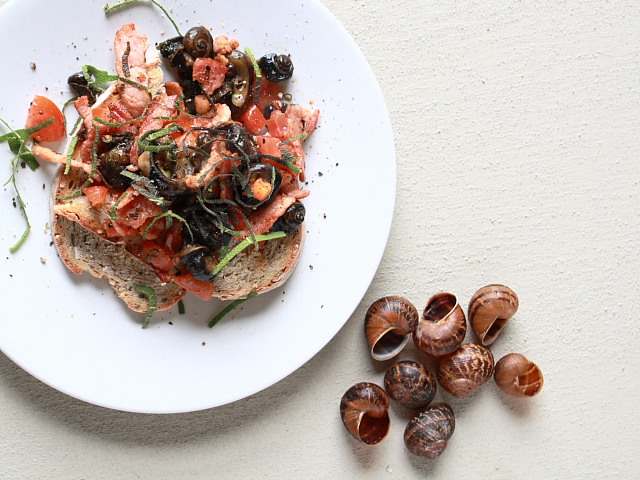The first thing to say about my very small attempt to farm garden snails for culinary purposes is that its been controversial.
“It’s worse than the live crabs in the sink incident“, Jenny said, “but not as bad as the pig’s head in the fridge.” Personally, I think it’s far worse than the pig head incident…I didn’t have to kill the pig, after all.
This little experiment seemed to catch the imagination, provoking reactions ranging from horror to intrigue, long facebook conversations about the ethics of eating things like snails, and the formation of an official pressure group, the Snail Liberation Front, bent on saving said snails from the pot.
Like many other pressure groups, it failed, but it did produce some hastily-pushed-through-our-door posters with remarkably good drawings of snails and the epic strap line “only Tories eat snails”, which I must admit made me pause for a moment and consider releasing my prey.
So, these snails…
All snails in Britain are edible. They’re essentially the same creatures that the French , Spanish and Italians devour by the tonne. The small, colourful ones aren’t worth the bother, and Roman snail, predominant in the South and South West are protected, so that leaves helix aspersa, the common garden snail.
It’s not as large as the farmed French varieties, but it’s a reasonable size for eating, and extremely plentiful, as anybody with an allotment will know.
If you set aside the emotion of it all, it makes perfect sense to eat snails. Why kill them with poison or the sharp edge of a spade when you can use them properly, for food?
It’s a far more ethical and sustainable approach.
It make s perfect, logical sense, but there’s a cultural angle to the whole act of eating a snail that simply revolts many British people, which is a shame, because snails are very good to eat indeed.
The French know this already, of course.

The best time to catch snails is after a downpour. At this time of year, the conditions are perfect – the humidity and dampness draws the little blighters out from under their rocks and out of their cracks and into the open at dusk. A quick shower, a mild evening, a bucket and a strong torch are all you’ll need for a bountiful hunt.
Snails need to be prepared quite thoroughly before they’re ready to cook. You don’t know where they’ve been and what they’ve been eating, so you need to change that by controlling their diet for a few days.
Put the snails into a container of some sort – a wicker basket of some sort, or something equally breathable is ideal – along with a carrot, and cover the container with something suitably heavy and snail proof. A roofing slate or something like that would be ideal. Put the container somewhere shady, out of the sun.
The next day, rinse the snails and the container with cold water to clean away any…droppings. Replace the carrot and cover again. Repeat this cleaning process for at least four days, by which time, the diet of carrot should be very evident from the colour of the snail’s waste product…it should be orange.
At this stage, you can be confident that you know what’s in the snail’s stomachs, but you don’t want to eat that.
Time to get it out.
Remove the carrot, but continue the daily rinsing routine. Do this for a further three or four days, to purge the snails of all waste products and to make sure that they’re very clean.
Just before you start to cook them, give the snails a final bath in plenty of water in a bucket, to make sure that all grit is removed from their shells.
Put the cleaned snails into a bowl, cover with a plate and place in the fridge for half an hour – the cold forces the snails to retract into their shells and puts them into a deep sleep.
Cooking is easy. Make a court bouillon, a simple vegetable stock flavoured with herbs, carrot, celery, onion and whatever else you’ve got in the fridge, and bring it to a rolling boil. The snails simply go straight into the pot. The heat kills them straight away, in the same way it does a mussel.
Cook for about fifteen minutes, making sure that the stock stays at just under boiling point.
Fish the cooked snails out with a slotted spoon and let them cool for a while before using a pin or a pair of tweezers to drag the flesh out of the shells. It will come out quite easily once you get hold of it.
The traditional French way of preparing snails is to stuff the snail back into its shell with a drop of stock and a lot of garlic butter, roasting in the oven for about ten minutes, but I served mine on toast, with crisp bacon, tomato and sage.
Sage goes well with snails – both have an earthy taste…
Does the thought of eating garden snails repulse you, or is it something that you’d dare to try?


